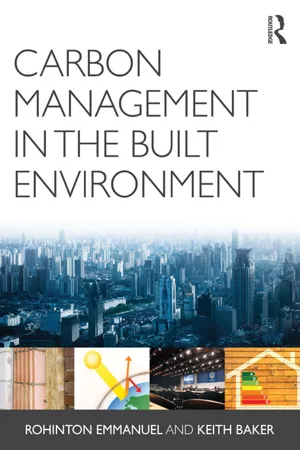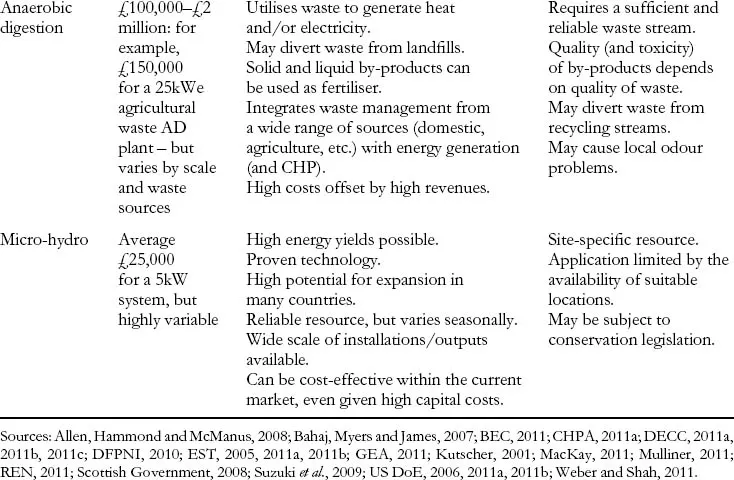![]()
Section B
Strategies for a low carbon built environment
![]()
4 Energy generation for a low carbon built environment
4.1 Micro and distributed generation
4.1.1 Solar thermal
4.1.2 Solar photovoltaics
4.1.3 Micro wind
4.1.4 Ground source heat pumps
4.1.5 Air source heat pumps
4.1.6 Geothermal
4.1.7 Micro and community CHP and biomass
4.1.8 Anaerobic digestion
4.1.9 Micro-hydro
4.2 Centralised renewable generation
4.2.1 Hydropower
4.2.2 Wind farms
4.2.3 Solar farms
4.2.4 Wave and tidal power
4.2.5 Biomass
4.2.6 Nuclear
References
Determining which technologies to invest in to best meet our increasing energy demands whilst decarbonising energy supply is probably the most divisive topic for those working in the fields of energy and the built environment. Very few would argue with the need to move away from fossil fuels, but towards what, and how fast? Experts agree that the ‘what’ needs to be a mix of technologies, but in what proportions, and are there any that should be excluded?
Humanity has yet to develop a low carbon energy technology that can meet demand whilst being acceptable to everyone, and many alternative technologies face significant public opposition. Even writing about some of these immediately leads to accusations of bias in favour of whichever technologies fare better in the analyses.
The first summaries presented here focus on micro and distributed generation technologies that are currently on the market. Where the efficiency of a technology is expected to improve without significant innovation, this is noted. The costs quoted for each technology come from a range of sources (primarily from the UK and the USA) and exclude savings from subsidies. They are intended to represent reasonable boundaries but should not be considered absolutes. Owing to the range of financial incentives for different technologies that are available around the world and the frequencies with which they change, any summary of these would be extensive and quickly out of date. However, understanding the types and levels of incentives that apply to each technology, as well as any relevant local, national and international legislation and regulation, is essential in selecting the most appropriate technology (or technologies) for each individual need.
Geography also has a huge role to play, both local and global. In the case of renewables, solar is obviously most efficient at lower latitudes, whereas wind and wave tend to favour more exposed locations at higher latitudes. However, solar is perfectly viable even at high latitudes, and exploiting manufactured wind tunnels in the built environment may provide new sources of wind power. Similarly the viability of combined heat and power (CHP) depends significantly on the local built environment, but there also needs to be a reliable fuel supply; and the selection of any large scale technology has to consider the local availability of the resource and the carbon cost (and other impacts) of any fuel imports.
Nevertheless, this chapter is intended to provide a brief overview of the current renewable and low carbon alternatives to fossil fuels, with a particular focus on micro and distributed generation in the built environment.
4.1 Micro and distributed generation
Micro and distributed energy generation technologies are an increasingly common feature of built environments and are expected to have a significant role to play in shaping our energy future. Some of these technologies are more visible than others; for example, wind turbines installed on rooftops stand out more than solar panels (which may go almost unnoticed from below when installed on urban infrastructure), whereas ground source heat pumps are largely invisible after installation. Some are more flexible than others; for example, solar lends itself to a huge range of applications, whereas micro wind and hydro are more resource dependent. However, inevitably, cost is a major factor in determining the appropriateness of each technology for any given application, and critically so is the ‘payback period’ – the length of time needed to recoup the investment from generating electricity and/or heat. Therefore, given the cost per unit output from these technologies, the availability of subsidies and other financial incentives, along with the long term financial signals (i.e. political and corporate commitments that any incentives will not be open to sudden and drastic changes), is essential in building investor confidence – whether those investors are individual householders or large organisations.
However, in most countries the key barrier to enabling greater uptake is electricity infrastructure designed for high output, centralised, fossil fuelled generation (see 3.1, ‘Energy generation’). The costs of restructuring inevitably lead some to argue that strategies to decarbonise electricity and heat supplies should focus on centralised renewable generation, particularly higher output options such as wind and solar farms. Yet these tend to be most suited to locations away from large human settlements and therefore also require significant investment in new infrastructure.
In reality the future of renewable and low carbon energy generation looks set to be a healthy mix of types, scales and applications of different technologies. Centralised renewables and low carbon technologies will be essential in ensuring ‘baseload power’ (the minimum level needed to ensure that heavy industry and essential services can operate uninterrupted at all times). However, the significant potential of micro-generation technologies to harness local resources to meet energy demands, particularly for off-grid properties and those in highly urbanised areas, makes them an essential tool for reducing emissions from the built environment, whilst at the intermediate scale ‘community level’ applications of distributed generation technologies look set to grow in their contribution to meeting energy demands. These include stand-alone wind turbines, ground source heat pumps, and CHP.
Table 4.1 provides an overview of the most common micro and distributed generation technologies appropriate for urban and rural built environments.
Table 4.1 Comparative advantages and disadvantages of different distributed and micro-generation technologies
4.1.1 Solar thermal
Solar thermal or solar hot water (SHW) panels are probably the most commonly installed building-integrated renewable technology. Solar thermal panels (also known as ‘collectors’) can be fitted at optimal angles on rooftops and contain a liquid, usually an antifreeze, which is heated by the sun and pumped to heat water in a boiler. Although output is depe...



